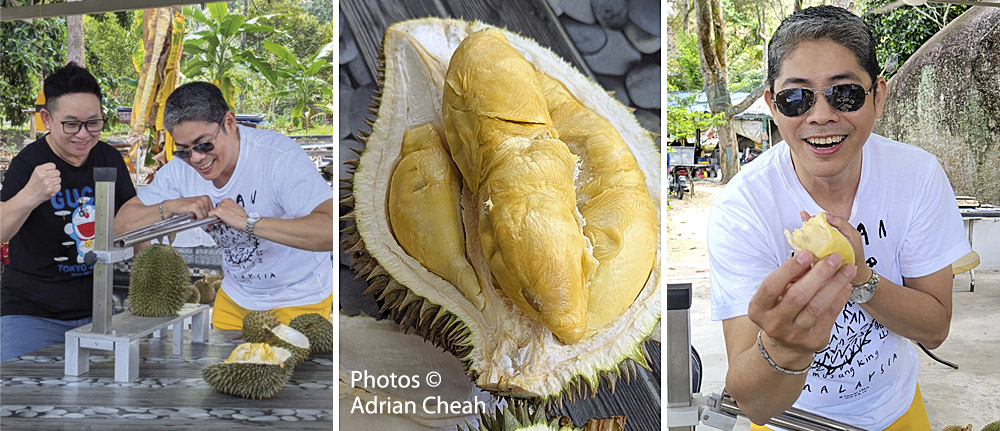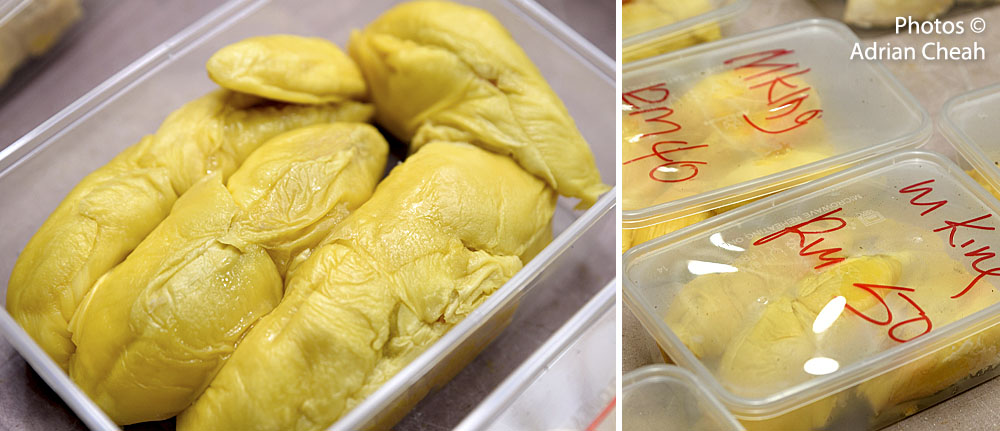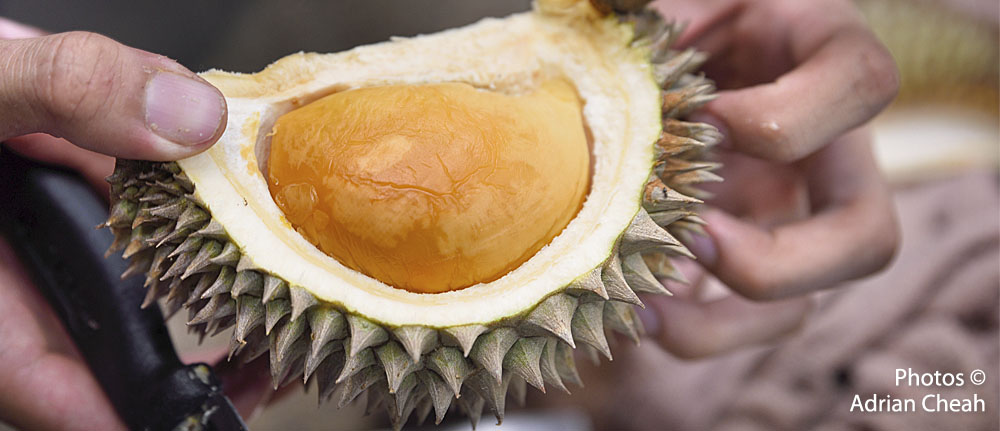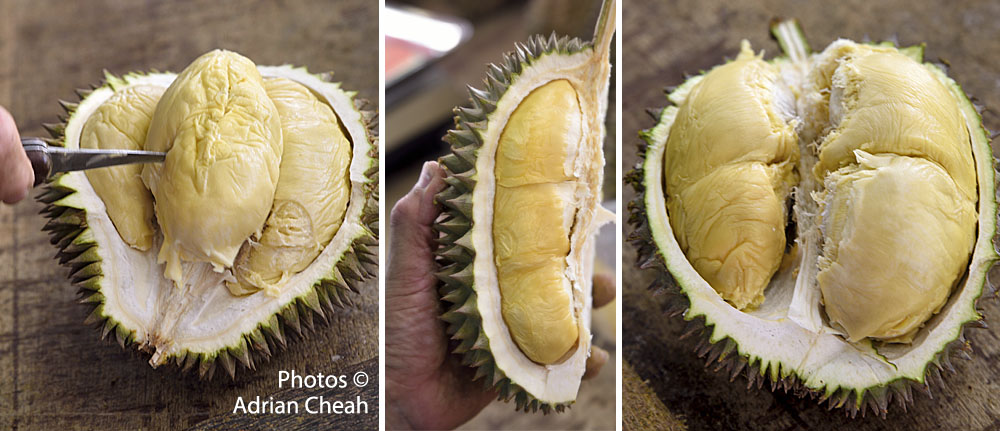Types of durians I am crazy about

People have their own preferences when it comes to durians and mine lean strongly towards fruits from older trees. These tend to yield durians with a smoother, creamier texture and a deeper, more pronounced aroma and flavour. Interestingly, even durians from the same tree can taste different from one season to the next, influenced by soil composition and changing weather conditions. For instance, the much-coveted Or Chi (Black Thorn) does not always deliver the same profile each year.

Still, nothing quite compares to the taste of durian. Here are some varieties I am crazy about, listed in no particular order.
Musang King (Mao Shan Wang in Mandarin)

Also known as Raja Kunyit in Malay, Musang King is undoubtedly one of the most sought after varieties. The fruits fetch high prices for their irresistible deep egg-yellow flesh that is bittersweet, rich and liam chooi (a Hokkien expression for its smooth, creamy and slightly dry-sticky texture). Having just the right balance of bitterness and sweetness, it does live up to its reputation as being the crème de la crème of durians. The tasting experience is highly memorable and if you are going for a durian buffet, it is often served last, marking the highlight of the feast.

In addition to its strong export demand, Musang King (D197) has found its way into a wide range of products, including ice cream, cakes, pastries, mooncakes, coffee, tea, whiskey and even novelty items such as flavoured condoms. Its popularity has driven prices sharply upwards in recent years (2022: RM58 – RM90 per kilogramme).
Or Chi / Ochee (Black Thorn in Hokkien)

Like Musang King, Or Chi is another premium variety that commands a high price (2022: RM85 – RM105 per kilogramme). If you love Musang King, Or Chi is well worth seeking out – if you can get your hands on it! It is in such high demand that there is a standing order at certain orchards in Penang.

The flesh of the Or Chi is thick, custard-like and tinted with a distinct orangey-pink hue. Its flavour is intense, layered and bittersweet, with a slightly sweeter profile than Musang King. Some describe a subtle hint of whiskey on the palate, adding to its complexity. This is a durian best savoured slowly. Not because it is “eating gold” (chiak kim in Hokkien), but because taking the time to let the flavours unfold reveals its depth and richness. It is low in fibre and distinctly liam chooi.
Originating from Penang, Or Chi is a source of local pride. In 2012, it emerged victorious in the Penang State Durian Competition, dethroning the national favourite Musang King! The following year, the Malaysian Agricultural and Research Development Institute (MARDI) officially registered the cultivar as D200, with Leow Cheok Keong’s farm recognised as its source.

The name Or Chi likely originates from a small black “thorn” or tail that protrudes from the base of the fruit, which is actually the dried stamen of the flower. According to my good friend Eric Chong of Green Acres, all durians have this feature, although many break off when the fruit falls. Eric runs Green Acres, a flourishing organic orchard in Balik Pulau with over 500 trees, some more than a century old. During the fruiting season, his schedule is packed. On one occasion, he shared with me an Or Chi that was truly "divine"!
Ang Haeh (Red Prawn in Hokkien)

When it comes to colour, Ang Haeh stands out from the rest of the variants with its uniquely dark pastel orangey-red hue. It has a dense, creamy texture and a pronounced sweetness, making it especially appealing to those who prefer milder flavours and shy away from bitter notes. That said, the taste can vary depending on the age of the tree. Younger trees tend to produce sweeter fruits, while older ones yield flesh with a stronger aroma and a touch of bitterness. Occasionally, there may be a faint alcoholic note in the bittersweet specimens. Most Ang Haeh fruits have small to medium-sized seeds, which means more creamy flesh to enjoy. When comparing Ang Haeh with Or Chi, the latter has a firmer texture, while Ang Haeh has slightly more fibre. The Ang Haeh is a hybrid breed officially registered under the Department of Agriculture Malaysia in 1990 with the code D 175.

If you love pulut durian (glutinous rice with durian smothered in a thick coconut milk sauce), Ang Haeh would be an ideal choice because of its sweet and bulbous flesh. Some prefer to sweeten the sauce with sugar, but a more traditional option is to grate fine shavings of gula melaka (palm sugar) over the dish before serving. A pinch of salt added to the sauce further enhances its "lemakness", complementing brilliantly the creamy Ang Haeh flesh. This is one satisfying and hearty meal that will keep you feeling full for hours. Besides Ang Haeh, you can opt for other varieties that have a thick flesh and sweet taste.
Ang Bak (Red Flesh in Hokkien)
Ang Bak and Ang Haeh are very different in taste and texture. The former has a slightly firmer texture with only a moderately thick pulp and a creamy sweet taste. Contrary to its name, you will not find crimson red flesh in Ang Bak; rather, it has a golden hue with a slight tinge of orange. Between these two varieties, Ang Haeh to me is a better option to consider.
This variety was registered with the Department of Agriculture Malaysia in 1987 under the code D164 by Teoh Eng Eng of Balik Pulau, Penang. That same year, Ang Bak clinched third place at the Penang State Durian Competition.
Capri

Another variety that I like is Capri with its thick ivory-coloured flesh. It has a creamy and sweet taste with distinct hints of banana and rum nodes. I cannot get enough of this underrated variety. Maybe it is because of its pale white flesh that hampers its marketability. Colour aside, Capri ranks high on my list of delectable durians.
The best way to enjoy durians is to sample a variety in one sitting. This allows your palate to detect the nuances that make each cultivar distinct. Despite being the same fruit, durians can deliver a remarkable range of flavours. Include Capri in your next tasting and it might just surprise you.
XO, D 24 / Sultan
Like Capri, some XO fruits have a pale off-white shade and a distinctively soft and moist flesh. The colour can also range from pale sage green to shades of yellow, depending on the region, altitude and age of the trees. This variant also has a strong bitter taste with an alcoholic twist (thus the name XO) and a strong aroma. This is ideal for those who prefer durians with a strong and bitter profile. Although the bitterness is obvious, its flesh is sweet as well (unlike bitter gourd or coffee, sans any sweetness). Each compartment has only one to three fleshy pods.
Because of its pale colour, XO is also not as popular as its golden, sun-kissed cousins. However, colour to me comes only a distant second from the character and taste profile of the fruit. In my book, the XO thick flesh and small flat seeds make this variety far more superior to many of the yellow flesh counterparts. If you come across XO, buy and indulge in it. Better still, you do not have to pay an arm and a leg for it.
I would not recommend opening the fruit and placing it in a plastic box for later consumption. Handling this fruit would turn it into a mushy mass. Always enjoy it straight from the fruit.
According to Ang Hock Leng, commonly known as Ah Leng who sells durians at Anson Road in Penang, XO is part of the D 24 variant, fruits coming from older trees at higher altitude. To me, XO is of a higher quality than D 24. This only goes to illustrate that even under the same classification/code, there is an obvious split that branches off into various subtypes. Ah Leng's stall provides al fresco dining under shaded trees and is popular among tourists and locals due to its location and quality durians.
D 24, one of the most popular durian clones in Malaysia, was very saleable in the 1990s before the craze for Musang King took the world by storm. D 24 strikes a good balance between sweet and bitter flavours with a thick, firm smooth and creamy flesh. It also has a mild alcoholic aftertaste. The yellow flesh has a less pronounced flavour compared to Musang King, making it a less overwhelming option. For those sampling durians for the first time, D 24 would be a good start.
Some unscrupulous durian vendors could short-change you by dishonestly selling you a D 24 as a Musang King. Understanding the difference between the two varieties would enable you to avoid such embarrassing situations.
The first thing to look out for is the colour of the fruit. A Musang King has a greenish-yellow ochre shade with a noticeable colour gradient from the tips of the thorns to the base. On the other hand, a D 24 has a homogenous green all around the fruit. The thorns in Musang King are fairly large, set fairly far apart whereas in D 24, the thorns are in clusters. The obvious difference is at the bottom of the fruit where the seams to open the durian run. These seams run into a five-pointed star shape at the base of a Musang King that is very visible; in the D 24, the seams are completely covered with thorns. If you look at the "crown" circling the stem of a Musang King, it is smooth with a little gap before thorns start. Also, Musang King has a relatively longer stem than D 24. With this in mind, you could save yourself from being hoodwinked.
Cheh Phoay (Green Skin in Hokkien)
I enjoy all types of durians from sweet to bitter ones. Cheh Phoay is definitely more bitter than Musang King but less so than XO. It also has a stronger sweet aroma and a firmer texture than XO. Although it has less oomph than XO, it is still a wonderful option to savour. The fruit has a melon-like shape and a bright green skin (thus the name). Also note that the seeds are rather big and the yellowish pulp (colour like fresh butter) is slightly fibrous but liam chooi. It is registered as D 145.
Hor Lor (Bottle Gourd in Hokkien)

Hor Lor has a peculiar elongated shape, with a curvy inner compartment that resembles a calabash, commonly known as bottle gourd (hence its name, Hor Lor). The flesh is very creamy, has a slightly dry consistency and a tinge of bitterness. It is less pungent compared to other durians. It is generally a mild tasting durian with medium to fairly large size seeds and a good amount of flesh. However, if the durian hits the ground hard when it falls, the pastel yellow flesh could have a stronger bitter thereafter.

Originating in Balik Pulau, Penang, Hor Lor was registered as D 163 in 1987 with its origin listed to Chat Fatt Hin. It also emerged winner in the state durian competition in Balik Pulau in 1987.


There is an incredible variety of durians available, and although I have listed some of my favourites, there are many others I enjoy as well. Above all, durians must be enjoyed "fresh". Beware of vendors who sell "stale" fruits that are previously kept in refrigerators overnight. Older trees offer more complex flavours and I am constantly surprised by some kampung durians that have yet to be registered and given a code. I am certain that you have your own favourites too. Taste is deeply personal, shaped by our neural responses and the flavours we grow to love and appreciate. It should not be dictated solely by prices. Although some may insist that the most expensive durian is the best, that is not always the case. When it comes to this King of Fruits, what truly matters is discovering and enjoying what resonates with your palate.
------------------------------------
Photographed and written by Adrian Cheah
© All rights reserved
30 June 2022